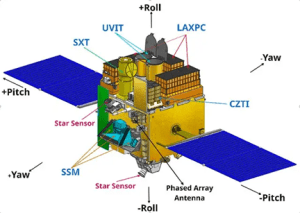TAG: GS 3: SCIENCE AND TECHNOLOGY
THE CONTEXT: AstroSat, India’s space telescope, has achieved a groundbreaking feat by measuring X-ray polarisation from the Cygnus X-1 black hole.
EXPLANATION:
- It marked a significant advancement in the study of black hole environments.
Background on Cygnus X-1:
- AstroSat is India’s first dedicated Space Astronomy Observatory.
- It was launched into a 650-km, 6° inclination orbit on September 28, 2015, with a lift-off mass of 1515 kg, by PSLV-C30 (XL) rocket from Satish Dhawan Space Centre Sriharikota.
- AstroSat carries a total of five scientific payloads enabling imaging, studying temporal and spectral properties of galactic and extra- galactic cosmic sources in a wide range of wavelengths on a common platform.
- Cygnus X-1, discovered over four decades ago, is among the first confirmed black hole systems in our galaxy.
- It is positioned at a distance approximately 400 times greater than the Earth-Sun distance.
- It comprises a black hole twenty times the Sun’s mass and a companion supergiant star, forty times more massive than the Sun, forming a binary system.

Instrumentation and Contribution:
- AstroSat spacecraft has the following five payloads:
- Ultra Violet Imaging Telescope (UVIT), developed by IIA, consist of two identical telescopes of aperture 380 mm. One telescope covers FUV (130–180 nm) band and the other covers NUV (200–300 nm) and visible band (320–550 nm). The hyperbolic mirrors are super polished.
- Large Area X-ray Proportional Counter (LAXPC), developed by TIFR has three identical gas detectors. LAXPC has a total effective area of 8000 cm2.
- Cadmium–Zinc–Telluride Imager (CZTI), developed by TIFR works in 20–100 keV. The imaging capability is achieved with coded mask. CZTI also has the capability of making X-ray polarization measurements.
- Soft X-ray Telescope (SXT), developed by TIFR, uses X-ray reflecting mirrors and an X-ray CCD for imaging and spectral studies in 0.3–8 keV.
- Scanning Sky Monitor (SSM) developed by ISRO is an all sky monitor for detecting and monitoring transient sources and for follow-up studies of known X-ray sources in 2.5–10 keV region.
Significance of X-ray Polarisation:
- While normal X-ray measurements focus on energy or intensity, the polarisation of X-rays provides insights into the orientation of the oscillating electric field.
- This information unveils crucial details about the geometry and other properties of the black hole.
Connection to Black Hole Jet Emissions:
- The study successfully linked high-energy X-ray radiation to the black hole jet in Cygnus X-1.
- The measurement of high polarisation in the 100-380 keV range suggests that radiation emitted from the source above 100 keV likely originated from the black hole jet.
Scientific Implications:
- The polarization data obtained from Cygnus X-1 offers a unique perspective on the immediate vicinity of the black hole.
- from the Inter-University Centre for Astronomy and Astrophysics (IUCAA) highlighted that polarization, as one of the properties carried by photons, helps unveil information about the accelerating charged particles emitting light.
Conclusion:
- The successful measurement of X-ray polarisation from Cygnus X-1 by AstroSat represents a significant milestone in astrophysics.
- The study not only advances our understanding of black hole environments but also showcases the prowess of Indian space science and collaborative research efforts.
- The results open new avenues for unraveling the mysteries surrounding black hole jet emissions, contributing to the broader body of knowledge in the field.

